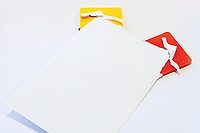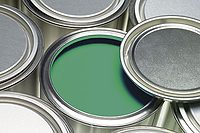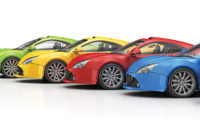The ColorCARE Concept

Among the most visible determinants of quality and customer satisfaction is the original paint finish of a vehicle when it is delivered to a customer. One of the first things an owner notices about the new car's finish is the color, and color differences between the car's body and the so-called add-on parts - like mirrors and bumpers.
While the durability and general appearance of automotive coatings have improved dramatically over the years, color consistency at the factory continues to represent a costly challenge for automakers. With thousands of automotive colors on the market, establishing and maintaining a precise color match on an entire car is difficult, especially in matching OEM components with add-on parts. These parts are made of different materials (usually plastics) and painted by the parts suppliers in their own paint shops. Color-match problems may be caused by:
- differences between the application lines and equipment used by OEMs and add-on part suppliers;
- different paint technologies (e.g., waterborne basecoat on the body versus a high-solids basecoat on the add-on part);
- and batch-to-batch paint variations - especially if the batches come from different coatings suppliers.

"ColorCARE serves as a monitoring and early-warning system that enables OEMs to prevent color problems instead of fixing them after they occur," said Carl Weber, director of Marketing for BASF's Automotive OEM Coatings business in North America.
The tangible component of the ColorCARE concept is the ColorCARE ToolBox. The ToolBox is a Windows-based, network-capable data-analysis tool that detects color deviation at an early stage. When a deviation is detected on a vehicle, the so-called "build-out" of that vehicle can be stopped. The color problem can then be corrected by adjusting the paint or the application process to eliminate the cause of the deviation. The ColorCARE concept provides information that makes it much easier to identify the exact causes of a color deviation.
Implementation of the ColorCARE concept consists of several stages. First, a paint shop analysis establishes a color baseline during a two-week period. This baseline quantifies the actual color and the variation in color that is currently being achieved by the OEMs and their add-on part suppliers.
Next, we outline areas for improvement, identifying root causes and recommending proper remedies. This step may include recommending changes in the relative color "position" of the OEM batches or the add-on parts.
Once the system is in place, trained BASF technicians help the plant use color measurements to analyze and optimize the painting process and to ensure batch-to-batch accuracy and consistency.
This process is then repeated at the add-on parts supplier's paint shop. When ColorCARE is fully operational at the OEM plant and at the suppliers' plants, regular sharing of data leads to accurate knowledge of current color performance and makes it very obvious if a change needs to be made.
"The ColorCARE ToolBox is the heart of the ColorCARE concept," explained Kendall Scott, research associate for BASF's Automotive OEM Coatings business in North America. "It uses specially designed, proprietary measurement and analysis software that delivers unique graphic representations of a wide range of colorimetric data."
Although the software was designed by BASF, it allows the use of a variety of color-measuring instruments. A commonly used device is a multi-angle spectrophotometer that shines light on the painted surface at a 45-degree angle. The spectrophotometer measures the reflected color simultaneously from five angles (e.g., 15, 25, 45, 75 and 110 degrees). The software then displays values for these five angles and for three scales: lightness/darkness (DL*), red/green (Da*) and yellow/blue (Db*), e.g. 15 dimensions.

"Implementation of the ColorCARE concept can help eliminate significant nonconformance costs for OEMs," said Weber. "The most tangible benefit is the potential for more profit per unit by increasing the ‘first-run OK' rate."
According to Weber, the ColorCARE concept offers a number of other benefits for the OEMs:
- Higher customer satisfaction through improved color harmony and accuracy;
Early detection of color deviation;
Availability of all tolerance models;
Software adaptable to the specific needs of customers and suppliers;
Easy-to-understand graphical outputs of large data sets;
Compatibility with a wide range of measuring instruments.
As a result, OEMs are able to use statistical analysis to control the coating process in terms of color homogeneity and consistency. Highly informative graphical representations of measurement data, combined with sophisticated analyses gathered from a large data set, ensure batch-to-batch consistency at the assembly line and improve process compatibility between OEM and add-on parts supplier paint lines.
The ColorCARE concept and its software were first tested at the Audi plant in Ingolstadt, Germany, beginning in 1999. Following the successful testing of the "Audi tolerance model" for color approval, Audi adopted the ColorCARE concept in its Ingolstadt facility. Around the same time, a working group was set up in Germany to draft the DIN 6175-2 standard based on the successful model. This standard is used throughout Europe for defining color specifications to be used in automotive OEM coatings.
The reactions of automakers and accessory suppliers were so positive that approximately 35 European car and add-on part plants are now using the ColorCARE concept to control and optimize their coating processes. In 2002, following its widespread adoption throughout Europe, the ColorCARE concept was successfully implemented in North America, with the first installation at the Volkswagen plant in Puebla, Mexico. It is expected that, in 2004, the concept will see widespread adoption at all major OEM facilities and at many Tier 1 facilities in North America.
Recently, BASF's ColorCARE concept was honored with a 2004 PACE Award in the Manufacturing Process and Capital Equipment category of the Tenth Annual Automotive News PACE Awards competition. PACE stands for "Premier Automotive Suppliers' Contribution to Excellence." The award was established in 1994 by Automotive News and Cap Gemini Ernst & Young to honor automotive suppliers that have embraced innovation or reinvented themselves to meet the needs of their OEM customer.
"The ColorCARE concept is a truly innovative approach to color quality at the OEM level," said Weber "and it reflects one of the guiding principles of BASF's Automotive OEM Coatings business - what we call ‘zero headaches for our customer."
For more information, contact Andy Ladak, communications manager, BASF Coatings, 248/948.2088, e-mail ladaka@basf.com.
Looking for a reprint of this article?
From high-res PDFs to custom plaques, order your copy today!






